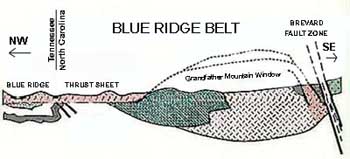
Geology of Grandfather
The Blue Ridge Mountains of western North Carolina and Eastern Tennessee are the result of the action of plate tectonics. The crust of our planet is composed of five primary plates, or huge pieces of rock which move very slowly over deeper layers of hot, pliable rock.

Some of the plates are composed of heavy oceanic crust, while others are made of lighter continental crust. At the middle of each oceanic plate a large crack pours forth lava onto the ocean floor. This causes oceanic plates to expand an inch or two every year. When oceanic crust is forced against continental crust, the oceanic crust is pushed underneath the continental crust. When continental crust is forced against continental crust, huge mountains usually are formed.
The Appalachian Mountains were formed in the remote past by collision of two continental crusts. During such mountain building, huge sheets of rock are pushed over each other. A rock layer called the Blue Ridge Thrust Sheet was moved over 60 miles to cover what is now Grandfather Mountain.
These mountains were once much higher (10 times as high!) than they are today. Erosion over hundreds of millions of years has carried away most of the rocks to form thick layers of sediment all across the Piedmont, Coastal Plain, and in the Atlantic Ocean. At Grandfather mountain, erosion has worn away the Blue Ridge Thrust Sheet from over top of the underlying younger rock, allowing us to study them. Geologists call this a “window” in time.

A “window” of this type is like an old pair of blue jeans through which the knee can be seen. The knee is the younger rock and the denim is the older rock layer. Erosion over the knee has created a “window” through which the younger material can be studied.
The entire Tablerock Thrust Sheet has been eroded away. Rocks of the Blue Ridge Thrust Sheet are much older than rocks within the Grandfather Mountain window. So are the rocks east of the Brevard Fault Zone.
Rocks on Grandfather Mountain are generally metamorphic. Pressure, heat, and the introduction of new substances cause metamorphism during mountain building. Changes include the development of new minerals, making a rock which has been deeply buried and compressed look very different from the original rock. Around the Nature Museum and at Split Rock you will encounter metamorphosed conglomerate. Around the upper parking lot the rocks are phyllite or meta-siltstone. The Swinging Bridge is built on granular pebble conglomerate rocks.
Read about the Faces and Profiles of Grandfather.
The geologic cross-section at the top of the page is scanned from Map I-709-A , Geologic Map of the West Half of the Winston-Salem Quadrangle, North Carolina, Virginia and Tennessee, by D.W.Rankin, G.H. Espenshade and R.B. Neuman, published by the United States Geological Survey in 1972.
